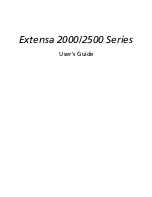
Notebook Training Manual for Acer TravelMate 4002LCi
Department of Education and Training
Version 1.0
2005
Page 31 of 35
Appendix D: Occupational Health and Safety
This document has been developed to inform Department staff of the potential
safety and health hazards associated with the use of notebook computers and
suggested strategies to reduce the risk of injury.
Notebooks offer a choice of environments and locations where a person can use them.
However the design of notebooks does not allow you to make some basic ergonomic
adjustments.
The risk of physical strain injuries to the neck, shoulders, and arms, and eye strain is
generally higher with notebooks than it is with desktop computers. This is due to the
inability to separate the keyboard and the screen and the variety of environments in
which a notebook is used.
Potential hazards with notebook use
The main feature of notebooks that causes problems is the lack of ergonomic adjustment
– this promotes poor posture. If the screen is at the optimal height for the operator then
the keyboard is too high, and if the keyboard is at the optimal height then the screen is
too low. Both scenarios may contribute to muscle discomfort or strain to varying degrees.
Potential injuries that can occur through using notebooks include:
§
Occupational Overuse Syndrome (OOS) [also known as repetitive strain injury
(RSI)] as a result of sustained unnatural postures and/or prolonged tension on
muscles, tendons, and other soft tissues.
§
Eye strain through use in environments where there is poor lighting, glare, or
reflection, and as a result of straining to view details on small screens.
§
Manual handling strain through carrying notebooks for extended periods and/or
lifting them out of awkward spaces. Strain may be the aggravation of an existing
injury.
Tripping hazards can also exist where the notebook has external cables attached such as
mains power cords or telephone lines.
Minimising the risk of strain or injury
It is not possible to adopt a good posture
when working with a notebook without
additional equipment. However there are a
number of ways that the risks can be
minimised.
If a laptop is to be used for extended periods
(more than 2 hours in any one session) an
external monitor and/or keyboard and mouse
should be used. Ideally the notebook should
be attached to a docking station. This allows
the monitor to be adjusted to the correct
height for the operator.
External keyboard, mouse and
monitor, with notebook in a docking
station





































